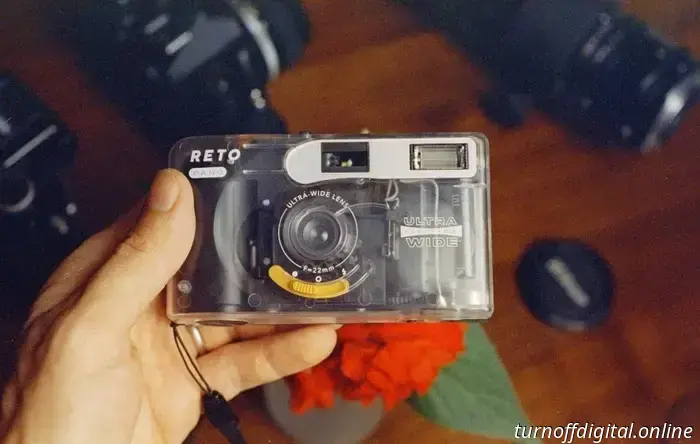
RETO Pano is an affordable, reusable compact camera featuring an ultra-wide 22mm lens and an optional panoramic mask. After using several rolls of film with the transparent plastic model, I am truly impressed by the value it provides. In this review, I will detail the positives, address a few drawbacks, and offer shooting tips for better images with RETO Pano.
In this review: Camera specifications, ergonomics and build quality, the built-in panoramic mask with a cinematic 2.35:1 aspect ratio, the 22mm ultra-wide lens, flash usage with RETO Pano, the best films for RETO Pano, pricing details, and more high-resolution sample photos. Support this blog and gain access to premium features with GOLD memberships!
The bottom plate of RETO Pano showcases the folded film rewinder crank (nearest my fingers), the yellow power switch, rewind unlock button ⏮️, “AAA” battery door (at the top of the photo), and a film advance winder wheel in the bottom-right corner.
Camera specifications.
RETO Pano utilizes standard 35mm film and can expose either in full-frame mode (35mm × 24mm) or panoramic mode (35mm × 14.9mm). Film transport is managed by a manual winder wheel at the bottom of the camera, alongside an unlockable rewinder crank on the other side. Additionally, there’s a retractable lens cover at the front of the camera that locks the shutter button when closed and a panoramic mode switch at the top.
This camera operates with a straightforward single-speed shutter of 1/100s and a single-aperture 22mm 𝒇9.5 2-element optical-grade acrylic lens. An onboard flash (GN ~11) can assist in low-light situations, powered by a single AAA battery. The camera weighs 93g/3⅓oz and measures 110mm × 62mm × 32mm (or 4.33” × 2.44” × 1.26”), primarily constructed from ABS plastic.
Ergonomics and build quality.
From my experience, RETO produces good quality cameras. They are inexpensive and plastic-made, which has its downsides, but in terms of design and finishing, their cameras rank among the best in their category. My sample is visually appealing: most mechanical and all electrical elements, including the flash PCB, are visible through the clear plastic body. I appreciate the contrast between the orange shutter and power slider. The camera is very lightweight and fits comfortably in almost any attire that can accommodate a phone. All components fit snugly together, and the camera feels solid in hand. It seems worth more than its $35 price.
However, there are a few concerns with RETO Pano. One issue is the tightness of the film advance wheel when operating. This can be common with cameras of this type—some films may require extra force to advance to the next frame. A more significant issue is how close the lens is to the gripping edge when taking photos. While this is not unusual, it can be uncomfortable for users with larger hands and increases the risk of fingers appearing in the shots. The lens is very wide, and the viewfinder does not indicate if a finger blocks the view. I've learned to be cautious after my second roll, but some images still had obstructions. Holding the camera with both hands may help.
My last concern involves the foldable film rewinder crank, which felt a bit tight and flimsy when I rewound my films back into the canister after finishing the last frame. Like any photographic gear, RETO Pano has a few quirks, but it offers significant enjoyment and can produce quality photos. The viewfinder is large and comfortable, even with the mask in use. I have had no issues composing shots, even while wearing glasses. The shutter button feels nice, and the translucent lens cover conveniently swings away when the yellow tab is pushed to the “O” position for “Open” (or “On?”). A lens cover is quite handy for plastic lenses, which are more susceptible to scratches and damage than glass ones.
But of course, the key feature is the lens.
Captured with RETO Pano using Cinema Shorts 50D in panoramic mode with flash.
The built-in panoramic mask with a cinematic 2.35:1 aspect ratio.
There are various methods to create panoramic images with film and digital cameras, with cropping being the most common. This involves trimming the top and bottom of an image to alter its aspect ratio. However, cropping is not the ideal method, as it results in a lower overall resolution than the unaltered frame. Although digital cameras often rely on this, some film cameras, like the renowned Hasselblad XPan, can expose a longer section of the film strip and thus retain higher resolution for panoramic images. Unfortunately, the XPan is priced
RETO Pano is an affordable, reusable compact camera featuring an ultra-wide 22mm lens and an optional panoramic mask. After using the transparent plastic model with multiple rolls of film, I am truly impressed by the value it provides. In this review, I will discuss the positives, a few drawbacks, and offer a shooting guide for capturing better photos.